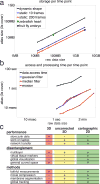Tissue cartography: compressing bio-image data by dimensional reduction
- PMID: 26524242
- PMCID: PMC5520999
- DOI: 10.1038/nmeth.3648
Tissue cartography: compressing bio-image data by dimensional reduction
Abstract
The high volumes of data produced by state-of-the-art optical microscopes encumber research. We developed a method that reduces data size and processing time by orders of magnitude while disentangling signal by taking advantage of the laminar structure of many biological specimens. Our Image Surface Analysis Environment automatically constructs an atlas of 2D images for arbitrarily shaped, dynamic and possibly multilayered surfaces of interest. Built-in correction for cartographic distortion ensures that no information on the surface is lost, making the method suitable for quantitative analysis. We applied our approach to 4D imaging of a range of samples, including a Drosophila melanogaster embryo and a Danio rerio beating heart.
Figures




References
-
- Krzic U, Gunther S, Saunders TE, Streichan SJ, Hufnagel L. Multiview light-sheet microscope for rapid in toto imaging. Nat. Methods. 2012;9:730–733. - PubMed
-
- Tomer R, Khairy K, Amat F, Keller PJ. Quantitative high-speed imaging of entire developing embryos with simultaneous multiview light-sheet microscopy. Nat. Methods. 2012;9:755–763. - PubMed
-
- Bosveld F, et al. Mechanical control of morphogenesis by Fat/Dachsous/Four-jointed planar cell polarity pathway. Science. 2012;336:724–727. - PubMed
-
- Reynaud EG, Peychl J, Huisken J, Tomancak P. Guide to light-sheet microscopy for adventurous biologists. Nat. Methods. 2015;12:30–34. - PubMed
Publication types
MeSH terms
Grants and funding
LinkOut - more resources
Full Text Sources
Other Literature Sources
Molecular Biology Databases

